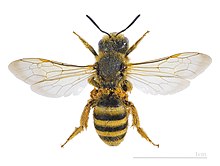Halictidae
| Halictidae | |
|---|---|

| |
| Halictus scabiosae - MHNT | |
| Scientific classification | |
| Kingdom: | |
| Phylum: | |
| Subphylum: | |
| Class: | |
| Order: | |
| Suborder: | |
| Superfamily: | |
| Family: | Halictidae Thomson, 1869, nom. protect.
|
| Subfamilies | |
The Halictidae are a very large and nearly cosmopolitan[1] family of the order Hymenoptera consisting of small (> 4 mm) to midsize (> 8 mm) bees which are usually dark-colored and often metallic in appearance. Several species are all or partly green and a few are red; a number of them have yellow markings, especially the males, which commonly possess yellow faces, a pattern widespread among the various families of bees. They are commonly referred to as "sweat bees" (especially the smaller species), as they are often attracted to perspiration; when pinched, females can give a minor sting.
Ecology
Most halictids nest in the ground, though a few nest in wood, and they mass-provision their young (a mass of pollen and nectar is formed inside a waterproof cell, an egg laid upon it, and the cell sealed off, so the larva is given all of its food at one time, as opposed to "progressive provisioning", where a larva is fed repeatedly as it grows, as in honey bees). All species are pollen feeders and may be important pollinators.

Eusocial species
Many species in the subfamily Halictinae are eusocial at least in part, with fairly well-defined queen and worker castes (though not the same as the caste system in honey bees), and certain manifestations of their social behavior appear to be facultative in various lineages.
Cleptoparasitic species
Several genera and species of halictids are cleptoparasites of other bees (mostly other halictids), and the behavior has evolved at least 9 times independently within the family. The most well-known and common are species in the genus Sphecodes, which are somewhat wasp-like in appearance (often shining black with blood-red abdomen- German: Blutbienen - usually 4-9 mm in body length); the female Sphecodes enters the cell with the provision mass, eats the host egg, and lays an egg of her own in its place.
"Nocturnal" species

Halictidae are one of the four bee families that contain some crepuscular species; these halictids are active only at dusk or in the early evening, so are technically considered "vespertine" (e.g. in the subgenus Sphecodogastra of Lasioglossum), or sometimes truly nocturnal (e.g. in the genus Megalopta). These bees, as is typical in such cases, have greatly enlarged ocelli. The other families with some crepuscular species are Andrenidae, Colletidae, and Apidae.
Systematics and evolution
The Halictidae belong to the hymenopteran superfamily Apoidea, series Anthophila. The oldest fossil record of Halictidae dates back to Early Eocene[2] with a number of species, such as Neocorynura electra[3] and Augochlora leptoloba[4] known from amber deposits. Currently, the family is divided into four subfamilies, many genera and more than 2000 known species. The Rophitinae appear to be the sister group to the remaining three subfamilies (Nomiinae, Nomioidinae, Halictinae) based on both morphology and molecular data.[5]
Systematics
Rophitinae:
- Ceblurgus
- Conanthalictus
- Dufourea
- Goeletapis
- Micralictoides
- Morawitzella
- Morawitzia
- Penapis
- Protodufourea
- Rophites
- Sphecodosoma
- Systropha
- Xeralictus
Nomiinae:

- Dieunomia
- Halictonomia
- Lipotriches
- Mellitidia
- Nomia
- Pseudapis
- Ptilonomia
- Reepenia
- Spatunomia
- Sphegocephala
- Steganomus
Nomioidinae:


- Tribe Halictini
- Agapostemon
- Caenohalictus
- Dinagapostemon
- Echthralictus
- Eupetersia
- Glossodialictus
- Habralictus
- Halictus
- Homalictus
- Lasioglossum
- Mexalictus
- Microsphecodes
- Nesosphecodes
- Paragapostemon
- Parathrincostoma
- Patellapis
- Pseudagapostemon
- Ptilocleptis
- Rhinetula
- Ruizantheda
- Sphecodes
- Thrincohalictus
- Thrinchostoma
- Urohalictus

- Tribe Augochlorini

- Tribe unknown
Notes
- ^ Pesenko, Yu. A. (1999). "Phylogeny and Classification of the family Halictidae Revised (Hymenoptera: Apoidea)". Journal of the Kansas Emtomological Society. 72 (1): 104–123. Retrieved 15 September 2013.
- ^ Engel, M.S., Archibald, S.B. An Early Eocene bee (Hymenoptera: Halictidae) from Quilchena, British Columbia. The Canadian Entomologist, Vol. 135, No. 1, 2003
- ^ Engel, M.S. (1995). "Neocorynura electra, a New Fossil Bee Species from Dominican Amber (Hymenoptera:Halictidae)". Journal of the New York Entomological Society. 103 (3): 317–323. JSTOR 25010174.
- ^ Engel, M.S. (2000). "Classification of the bee tribe Augochlorini (Hymenoptera, Halictidae)" (PDF). Bulletin of the American Museum of Natural History. 250.
- ^ Patiny, S. et al., Phylogenetic relationships and host-plant evolution within the basal clade of Halictidae (Hymenoptera, Apoidea). Cladistics 24 (2008) 255–269
References
- Engel, M.S. (2000) Classification of the bee tribe Augochlorini (Hymenoptera: Halictidae). Bulletin of the American Museum of Natural History 250: 1-89.
- Grimaldi, D. and Engel, M.S. (2005). Evolution of the Insects. Cambridge University Press. ISBN 0-521-82149-5.
{{cite book}}: CS1 maint: multiple names: authors list (link)
External links
- Family Halictidae Large format diagnostic photos, information.
- Everything About the Sweat Bee - Description and photo of the sweat bee.
- Image Gallery from Gembloux
- BugGuide – Search: Halictidae (North American species only).
- Online identification guides for eastern North American Halictidae
- Halictidae on the UF / IFAS Featured Creatures Web site
